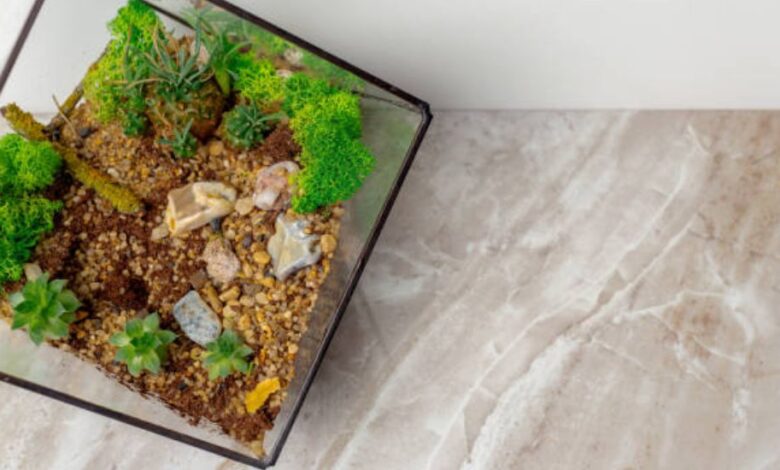Understanding the Living Terrarium Ecosystem Kit: A Guide to Self-Sustaining Ecosystems

A living terrarium ecosystem kit is an exciting way to bring a slice of nature into your home or office. These kits allow anyone, regardless of gardening expertise, to create a self-sustaining mini-ecosystem inside a glass container. The terrarium mimics natural environmental processes, offering a low-maintenance and visually appealing addition to any indoor space.
In this detailed guide, we will explore everything you need to know about a living terrarium ecosystem kit, from what it is to how it works, and why it’s a fantastic choice for nature lovers and beginners alike.
What is a Living Terrarium Ecosystem Kit?
A living terrarium ecosystem kit is essentially a DIY kit that contains all the components necessary to create a miniature, enclosed ecosystem. These kits are designed to be self-sustaining, meaning once set up, the plants within the terrarium can thrive with little to no external maintenance. The enclosed nature of the terrarium replicates a microclimate, complete with its water cycle, making it an excellent representation of how ecosystems function in the natural world.
Key Components of a Living Terrarium Ecosystem Kit
To understand how these kits work, it’s important to familiarize yourself with their key components. Every living terrarium ecosystem kit typically includes:
- Glass Container: The transparent container is vital for allowing light to reach the plants while keeping the environment sealed to maintain humidity.
- Substrate Layers: A terrarium often contains multiple substrate layers, including drainage stones, activated charcoal to keep the air clean, and potting soil for plant growth.
- Plants: Most kits include various plants that thrive in high-humidity environments, such as ferns, moss, and certain tropical plants. These plants absorb water from the soil and release it back into the air, ensuring a self-regulating water cycle.
- Decorative Elements: Kits often come with decorative items like rocks, wood, or small figurines that add an aesthetic touch to your ecosystem.
- Water: While some kits come with instructions for how to properly add water, most of the moisture within the terrarium comes from the plants’ natural transpiration.
How Does a Living Terrarium Ecosystem Kit Work?
A living terrarium ecosystem kit operates on the principle of a closed system, where water, carbon dioxide, and oxygen are continually recycled. When the terrarium is sealed, the plants transpire water, which evaporates and condenses on the glass, eventually falling back into the soil, thus providing water to the plants in an endless loop.
This ecosystem also regulates its own oxygen and carbon dioxide levels. During the day, plants photosynthesize, taking in carbon dioxide and releasing oxygen. At night, they respire, using the oxygen and releasing carbon dioxide, creating a balanced, self-sustaining environment.
Benefits of a Living Terrarium Ecosystem Kit
There are several benefits to owning a living terrarium ecosystem kit, which make them popular with both gardening novices and experienced hobbyists. Here are a few:
- Low Maintenance: Since the terrarium is a self-sustaining ecosystem, it requires little care once it’s set up. You might only need to water it once every few months or less, depending on the seal of the container.
- Aesthetic Appeal: Living terrariums are beautiful, compact, and can fit into any space. Whether on a desk, shelf, or coffee table, they offer a miniature window into nature that enhances any room.
- Educational Value: These kits are an excellent way to learn about ecosystems and plant biology. Watching the water cycle and understanding the delicate balance between oxygen and carbon dioxide inside the terrarium can be fascinating for both children and adults.
- Stress Relief: Studies have shown that adding natural elements to indoor spaces can reduce stress and increase productivity. A living terrarium provides a calming, green presence that can help improve mental well-being.
Types of Living Terrarium Ecosystem Kits
There are several types of living terrarium ecosystem kits available, each designed to suit different preferences and skill levels. Some common types include:
- Closed Terrarium Kits: These are fully sealed terrariums that create a humid environment ideal for tropical plants. The closed system allows for very low maintenance, as the ecosystem becomes self-sufficient over time.
- Open Terrarium Kits: In contrast to closed kits, open terrariums allow airflow and are better suited for plants like succulents and cacti that prefer drier conditions. They require more maintenance but are perfect for individuals who enjoy hands-on plant care.
- DIY Kits for Kids: These kits often include fun elements like colorful rocks, small figurines, or themes like a fairy garden, making them perfect educational projects for children.
- Themed Terrarium Kits: Some kits focus on aesthetics, offering specific themes such as rainforest or desert landscapes. These kits may come with more decorative elements, like hardscaping materials to create a miniature natural scene.
Setting Up a Living Terrarium Ecosystem Kit
Setting up a living terrarium ecosystem kit is relatively easy, even for beginners. Here is a step-by-step guide on how to set up your kit:
- Prepare the Container: Start by cleaning the glass container thoroughly. Ensure there are no residues that could harm your plants or affect the ecosystem.
- Create the Drainage Layer: Add a layer of drainage material, usually small rocks or pebbles, to prevent water from accumulating at the bottom and rotting the roots of your plants.
- Add Activated Charcoal: Activated charcoal is essential for keeping the air fresh within the terrarium and preventing any odors from developing.
- Place the Soil Layer: The next layer is the soil or substrate where your plants will root. Make sure it’s rich enough to provide nutrients for the plants.
- Plant Your Plants: Carefully place your plants into the soil. Mosses can be spread on the top layer, while plants with longer roots can be gently placed in small depressions in the soil.
- Decorate: Add any decorative stones, wood, or miniature items to personalize your terrarium. This is also an excellent time to arrange any hardscaping elements.
- Water the Terrarium: If the substrate is dry, add a small amount of water—just enough to moisten the soil. Remember, you don’t need much water because the closed system will recycle it.
- Seal the Terrarium: Finally, close your terrarium with a lid or cork to lock in the moisture and let the ecosystem start regulating itself.
Common Mistakes to Avoid
While living terrarium ecosystem kits are relatively easy to maintain, there are a few common mistakes to avoid:
- Overwatering: Adding too much water can cause mold and root rot, so always start with a small amount.
- Wrong Plant Choice: Not all plants are suitable for a terrarium. Make sure you use plants that thrive in humid, low-light environments like ferns, mosses, or tropical plants.
- Direct Sunlight: Placing your terrarium in direct sunlight can cause it to overheat, leading to plant stress or death. Instead, place it in a well-lit area with indirect light.
Conclusion
A living terrarium ecosystem kit is not only a beautiful addition to any home or office but also an educational tool that demonstrates the intricate balance of nature. Whether you choose a closed or open terrarium, the joy of watching your ecosystem thrive with minimal intervention is incredibly rewarding. By following the steps above and avoiding common mistakes, you can enjoy your very own slice of nature, encased in glass.
Incorporating a living terrarium ecosystem kit into your life is an excellent way to bring greenery into your indoor space, while also benefiting from the calming effects of nature. Whether you’re an experienced plant lover or just starting, these kits offer a simple, low-maintenance solution to enjoy the beauty of plants year-round.



